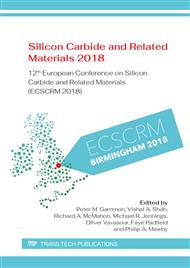p.101
p.105
p.109
p.114
p.119
p.123
p.127
p.131
p.136
Effect of Surface Etching Conditions on Stacking Faults in 4H-SiC Epitaxy
Abstract:
Epilayers grown on substrates etched by various etching conditions were studied for stacking fault defects. Substrates were etched by H2, H2+ HCl and H2 + CxHy gases prior to epilayer growth for comparison. High density of SF was observed in the epilayers when H2+HCl or H2+CxHy gas mixtures were used. On the other hand, much lower density of stacking faults (SF) (<1 cm-2) was observed in the epilayer grown on the surface etched by only H2 gas. However, a high number of pits were generated in the epilayer grown on substrate etched by H2 only, which can be considered to be tradeoff of achieving low SF in epilayer by substrate etching. We also conclude from our experimental results that C rich surface is more favorable to generate SF in epilayer compared to Si rich surface.
Info:
Periodical:
Pages:
119-122
Citation:
Online since:
July 2019
Authors:
Price:
Сopyright:
© 2019 Trans Tech Publications Ltd. All Rights Reserved
Share:
Citation:


